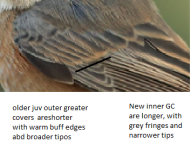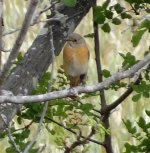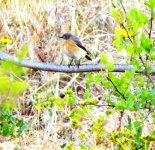Ken, people have already expressed an opinion regarding gender. Grahame and Jean Francois have clearly stated that they consider the bird to be female. Jane has stated that she can see a moult contrast and therefore considers it to be male.
Personally I see this bird to be fairly uniformly brown like a female, with perhaps a greyer tone to the upperparts than the average. As I have tried to state in two previous posts, I would expect a 1CY male to show more features suggestive of an adult - for example a darker throat and more rufous on the underparts, and I would expect a 2CY male to be indistinguishable from an adult. This seems to be supported in the links provided by Brian, although the links provided by Jane perhaps suggest a few 1CY males are less obvious.
To make sure there is no ambiguity, I will state clearly that I think this is a female that cannot be definitely aged.







